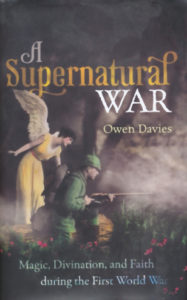Book Review: A Supernatural War
I’ve recently finished reading Owen Davies’ new book A Supernatural War: Magic, Divination, and Faith during the First World War (Oxford University Press, 2018).
As Owen Davies points out, the First World War has sometimes been termed the “the first scientific conflict” – a time punctuated by new technologies of warfare (tanks, warplanes, poison gas) as well as the emerging social and medical sciences. He then proceeds to lift the lid on the hitherto hidden aspects of the period – the appearance of magic, prophecy, divination and much more besides on both the battlefields and home fronts of Europe and America. And what a fascinating history this is – ranging from Spiritualism to battlefield mascots and talismans; from the activities of occult societies to fortune-tellers. Equally interesting is Davies’ account of the response of authorities in various countries to these manifestations of “superstition” – for example, he shows how authorities in both Germany and Britain sought to crack down on Fortune-telling, and gives several accounts of cases that came before the courts, and how practitioners sought to find loopholes in the law.
 No book on the supernatural aspects of the Great War would be complete without a discussion of the Arthur Machen-inspired vision of the ‘Bowmen of Mons’. But Davies shows how widespread such battlefield visions actually were. There were visitations of angels, the Virgin Mary and ‘the White Comrade’ – a mysterious figure who appeared before wounded soldiers, who, like Machen’s bowmen, seems to have originated in fiction. Again, there were tensions over such manifestations. Religious authorities seemed to have eagerly endorsed heavenly visions but showed more wariness over reports of deceased relatives – which was the domain of Spiritualism. Although Davies pays close attention to non-orthodox beliefs, he does examine the influence of the major faiths, for example noting how many soldiers carried a bible with them. He also describes the activities of various esoteric societies during the war and offers the “tantalizing hint” that occult grimoires too may have been circulating in the trenches – citing a report that an officer had confiscated from one of his soldiers, a copy of the Clavicula Salomonis.
No book on the supernatural aspects of the Great War would be complete without a discussion of the Arthur Machen-inspired vision of the ‘Bowmen of Mons’. But Davies shows how widespread such battlefield visions actually were. There were visitations of angels, the Virgin Mary and ‘the White Comrade’ – a mysterious figure who appeared before wounded soldiers, who, like Machen’s bowmen, seems to have originated in fiction. Again, there were tensions over such manifestations. Religious authorities seemed to have eagerly endorsed heavenly visions but showed more wariness over reports of deceased relatives – which was the domain of Spiritualism. Although Davies pays close attention to non-orthodox beliefs, he does examine the influence of the major faiths, for example noting how many soldiers carried a bible with them. He also describes the activities of various esoteric societies during the war and offers the “tantalizing hint” that occult grimoires too may have been circulating in the trenches – citing a report that an officer had confiscated from one of his soldiers, a copy of the Clavicula Salomonis.
Davies also discusses how the anthropologists, folklorists and other social scientists of the period responded to the war, as an opportunity to research evidence of magic, ghosts, and beliefs in luck. He discusses the various attitudes soldiers had towards lucky objects or persons, and how talismanic objects were mass-marketed.
The book closes with a look at the survival of magic and related practices into the inter-war period and the Second World War – I hope this a preface to Professor Davies writing a larger treatment of magic practices and beliefs in the Second World War. Although there seems to be no shortage of sensationalist (and sober) treatments of Nazi occultism, there is always room for a fresh look.
All in all, A Supernatural War is a fascinating and enthralling book which should be of great value to anyone interested in the history of magic in the twentieth century. If anything, it’s another nail in the coffin of the so-called “disenchantment” view that the onset of modernity banished magic into the shadows.
